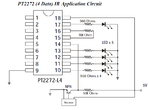dejavu51
Newbie level 6

Hey there ;-) I'm testing a remote controller with pt2262 ic as encoder and pt2272 - m4 as decoder with an ASK transmitter and receiver on a breadboard. when i connect the data out pin of pt2262 to the data in pin of pt2272 with a wire the circuit functions correctly but when i use the ASK transmitter and receiver the circuit won't work. any suggestion would be really appreciated :grin:
here are the ASK modules that I've Used :
**broken link removed**
**broken link removed**
And here is the schematic for my circuit:
**broken link removed**
I used One Voltage Regulator on the Bread board for the Both circuits and I didn't put any switches on the pin 10 till 14, instead I directly wired pin 10 to 5 volt and pin 11 till 13 to ground.
here are the ASK modules that I've Used :
**broken link removed**
**broken link removed**
And here is the schematic for my circuit:
**broken link removed**
I used One Voltage Regulator on the Bread board for the Both circuits and I didn't put any switches on the pin 10 till 14, instead I directly wired pin 10 to 5 volt and pin 11 till 13 to ground.
Last edited:

